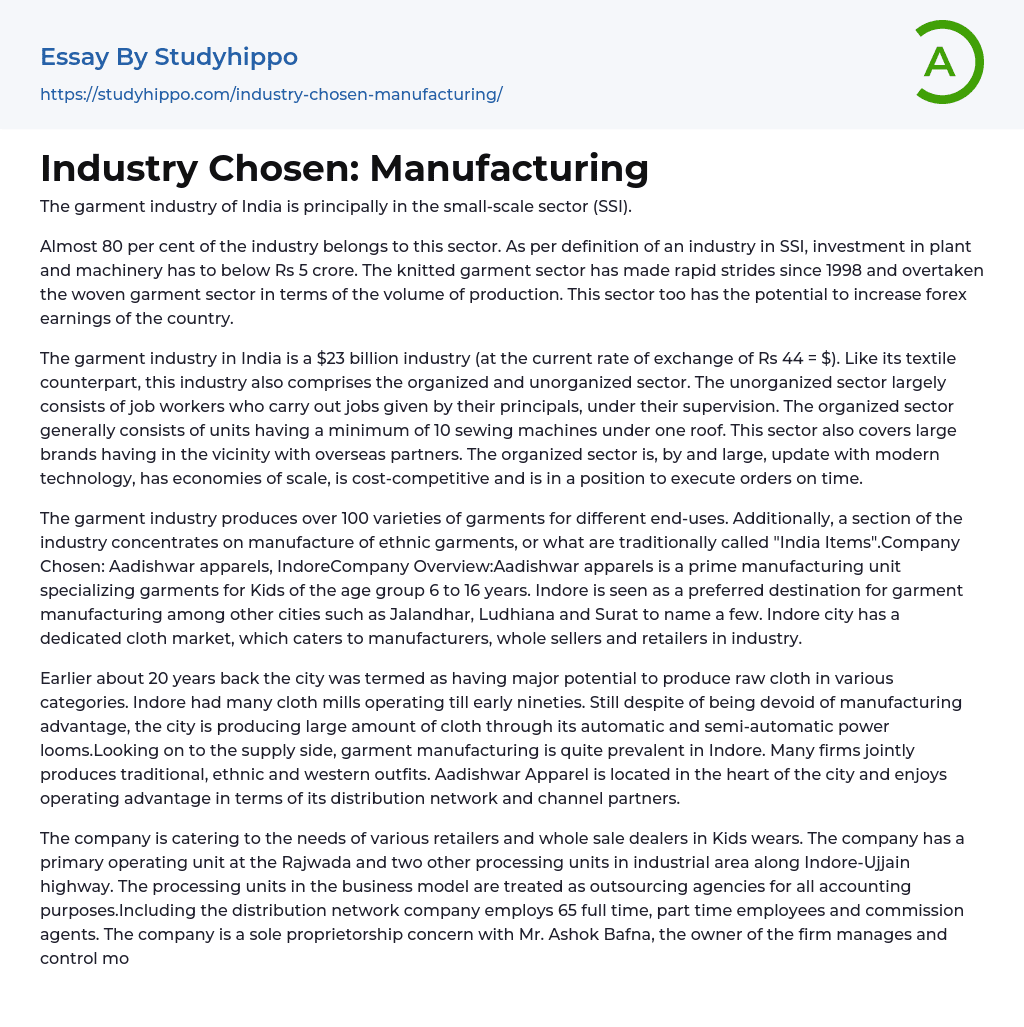The small-scale sector (SSI) dominates the garment industry in India.
Around 80% of the industry is categorized under the Small Scale Industry sector (SSI). According to SSI, an industry is considered as such if it has invested less than Rs 5 crore in plant and machinery. Since 1998, the knitted garment sector has experienced significant growth and has surpassed the woven garment sector in terms of production volume. This sector also has the potential to boost the country's forex earnings.
The Indian garment industry is currently valued at $23 billion, with a conversion rate of Rs 44 = $. The industry, similar to the textile sector, is divided into organized and unorganized branches. The unorganized sector comprises of job workers who carry out tasks assigned by their principals and operate under their supervision. Meanwhile, the organized sector encompasses units with a minimum o
...f 10 sewing machines under one roof and includes prominent brands that work alongside international partners. By keeping pace with modern technology, achieving economies of scale, being cost-competitive and maintaining timely order execution, the organized sector remains strong.
The garment industry is diverse, producing more than 100 different types of clothing to meet various needs. Another aspect of the industry focuses specifically on ethnic clothing, also known as "India Items". One company that operates in this industry is Aadishwar apparels, based in Indore. Specializing in clothing for children between the ages of 6 and 16, Aadishwar apparels is a top manufacturing unit in the city. Indore is one of several preferred cities for garment production, along with Jalandhar, Ludhiana, and Surat. The city boasts a dedicated cloth market that serves manufacturers, wholesalers, and retailer
within the industry.
Around two decades ago, Indore was known for its capability to produce a wide range of raw cloth. The city housed numerous cloth mills until the early 1990s. Despite no longer having a manufacturing advantage, Indore continues to produce a significant amount of cloth through the use of automatic and semi-automatic power looms. On the other hand, garment manufacturing is prominent in Indore with several companies working together to produce traditional, ethnic, and western apparel. Aadishwar Apparel, established in the city center, benefits from its distribution network and channel partners.
The company provides for the requirements of diverse retailers and wholesale dealers in Kids wears. There is a main operational unit located at the Rajwada, while two other processing units operate in the industrial area along the Indore-Ujjain highway. Accounting-wise, the processing units are viewed as outsourcing agencies under the business model. Along with its distribution network, the company hires 65 full-time, part-time employees and commission agents. The proprietorship is under Mr. Ashok Bafna's control and management, where he oversees most of the firm's business activities with his son.
At Aadishwar Apparel, Indore, the business office is located at the primary unit, which is a rented space. The firm has two accountants who assist with accounting and financial matters. The firm operates in four main areas.
The Material Handling Division is accountable for receiving raw materials and storing finished goods, including Work-In-Progress inventory. The Tailoring Division is responsible for cutting raw cloth into pre-specified designs to assemble the pieces for a specific design.
Following this, outsourcing units receive the necessary pieces for sewing and dyeing, which require prompt processing. In addition, the design division suggests
the specifications for the upcoming season's designs based on market surveys and feedback from retailers.
The Packaging and Delivery Division is responsible for conducting quality checks on finished items and their packaging. Cartons containing 5 pieces of varying sizes are uniformly packaged for various designs. This division also oversees the delivery of these cartons for distribution to wholesale dealers. The process begins with the procurement of raw materials.
The procurement stage involves sourcing a variety of materials for the production process. These materials are predominantly sourced from a range of suppliers located throughout the country, with a particular focus on Surat (Gujarat), Indore (M.P.), and Ludhiana (Punjab). In addition to cloth, this stage also encompasses the sourcing of metals, buttons, thread, and various other miscellaneous raw materials components.
At a certain store, raw materials are stored for product design. The designer utilizes CAD software to create different product types to meet market needs during the design phase. These designs are submitted for management authorization. Precutting starts after approval where all the clothing parts are cut according to design specifications. Each design is assigned a distinctive number allowing interdepartmental communication. Following precutting, the cloth items are forwarded for sewing.
Four primary garment types exist.
- Chief Executive Officer essays
- Convenience Store essays
- Firm essays
- Training And Development essays
- Unilever essays
- Variable Cost essays
- Virgin Group essays
- Bargaining essays
- Entity essays
- Pest analysis essays
- Jeans essays
- Factory essays
- Material essays
- Production And Manufacturing essays
- Alarm clock essays
- John Locke essays
- 9/11 essays
- A Good Teacher essays
- A Healthy Diet essays
- A Modest Proposal essays
- A&P essays
- Academic Achievement essays
- Achievement essays
- Achieving goals essays
- Admission essays
- Advantages And Disadvantages Of Internet essays
- Alcoholic drinks essays
- Ammonia essays
- Analytical essays
- Ancient Olympic Games essays
- APA essays
- Arabian Peninsula essays
- Argument essays
- Argumentative essays
- Art essays
- Atlantic Ocean essays
- Auto-ethnography essays
- Autobiography essays
- Ballad essays
- Batman essays
- Binge Eating essays
- Black Power Movement essays
- Blogger essays
- Body Mass Index essays
- Book I Want a Wife essays
- Boycott essays
- Breastfeeding essays
- Bulimia Nervosa essays
- Business essays
- Business Process essays




